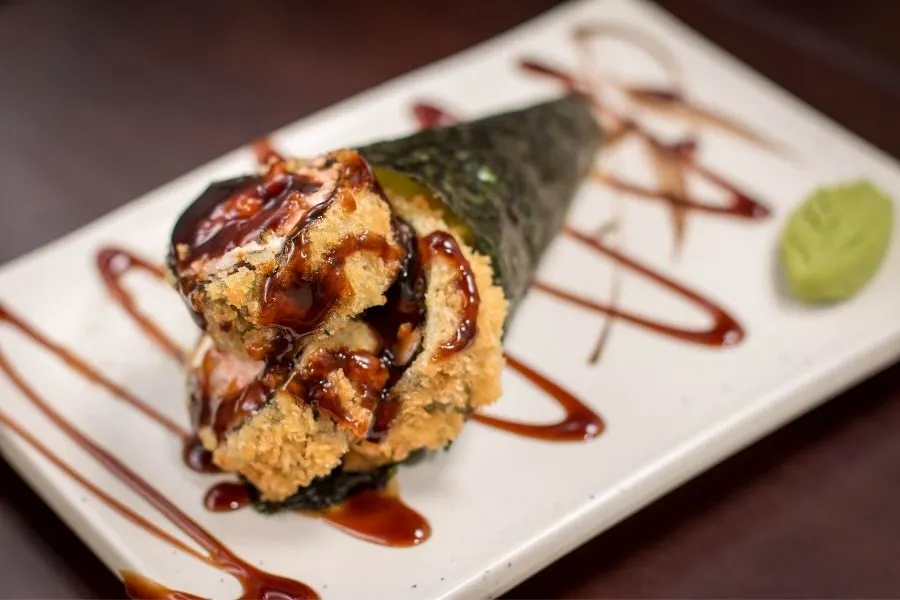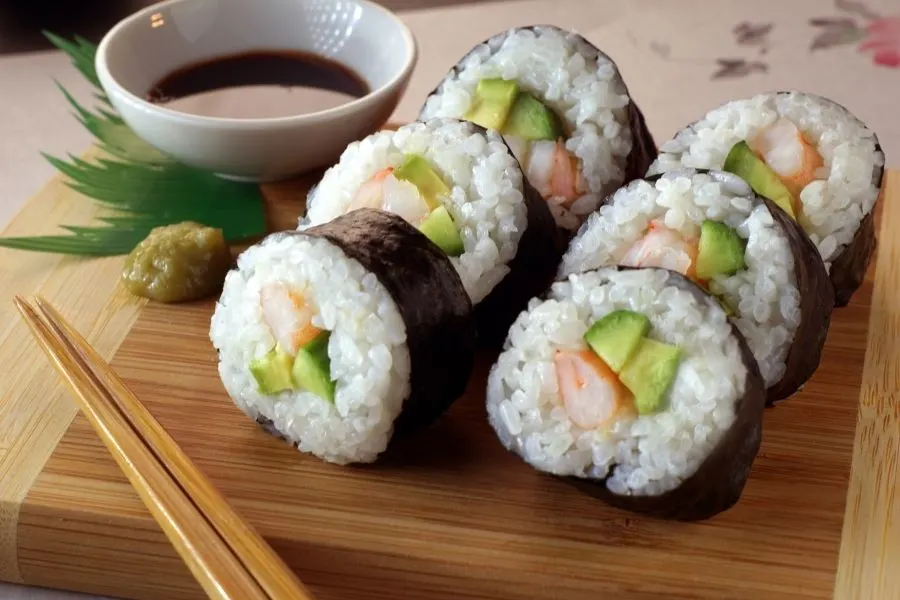Are you starting to fall in love with sushi as a food ? If yes then you’re probably racking your brain trying to remember all the different kinds of sushi. And have you met the maki and temaki rolls ? Yes ? And you’re wondering exactly why and how they’re different, since they’re both just rolls ?
Well that’s a great point you have right there. We’ll explore it right now, because temaki is just as common and popular as maki. This means you’ll find it on pretty much every sushi menu that serves at least decent food. Let’s talk.

Maki vs temaki
Maki is the typical sushi roll you see in restaurants, a cylinder cut into 6 or 8 pieces. Temaki is a cone made of the same ingredients as maki, but meant for a single person. Where you can share a maki, a temaki is hard to share and is much larger.
Both use nori sheets but the temaki absorbs moisture much faster, so it has to be eaten right after rolling. It cannot sit, unlike a set of temaki rolls.
There is also more skill involved when rolling a maki roll: how to layer everything, how tight to roll, and getting a clean cut. A temaki is much more beginner friendly, and can even be a child’s fun snack.
In short, both are popular Japanese sushi types and they provide mostly the same flavors. You can stuff a maki roll with whatever you put into a temaki, just with more care. Now let’s explain those differences in a little more detail.
1. Temaki is cone shaped, maki is a cut up cylindrical roll
The first way to tell the difference between maki and temaki is their shape. Maki is a cylindrical roll that is eventually cut into 6 or 8 pieces, and it looks like a savory Swiss roll.
Temaki uses a different technique, and needs the rice to be spread differently. You spread it on one side, add whatever toppings you want, then you roll the cone. It will end up looking like a flat ice cream cone, and the top part is meant to showcase the fillings.

Read also: Is Sushi Raw ?
You may also see temaki called hand roll, because that’s the literal translation of the word from Japanese. You may also find maki rolls listed as makizushi, which means rolled sushi. Still, it’s important to know these secondary names since not every restaurant provides photos of the food in the menu.
2. Maki is the typical sushi roll you see everywhere
If you’re unsure which you want to start with, know that the maki roll is the typical sushi roll you see everywhere. It’s made up of vinegared rice, fish, possibly a thin vegetable strip, all rolled with a very thin nori (dried seaweed sheet).
It’s the sushi roll you see everywhere, in movies and cartoons and even some games. It’s often pictured right next to nigiri, which is the thin strip of fish on top of an oval rice ball.
We haven’t see temaki in so many movies or games or cartoons. Probably because it’s less showy than a maki roll, and to be honest not so many people know about temaki (unless they’re Japanese or really into sushi).
3. Temaki is kid-friendly, easy to make
A really great point about temaki is how forgiving it is, and it’s very friendly towards kinds and beginners. You can make it at home much easier than you could a maki roll. You do need an eye for detail and a bit of dexterity, but nowhere near as much as for maki rolls.
This means you can let the kids have some fun and make their own food with this sushi style. As long as they’re supervised, and they have all the ingredients at their disposal, they can easily make their own temaki.
This roll uses a smaller nori sheet, so you can cut one in half and get two temaki sheets. Place the nori on the plate or table, add some rice on top, spread it out evenly but leave one side empty. In the middle of the rice add whatever fillings or toppings you like. Then start rolling the temaki from the rice side. The part with just plain nori should be rolled last, to seal the cone.
Don’t worry if it comes out a little wonky. As long as the bottom is sharp and closed off so rice doesn’t fall out, it’s alright.
This doesn’t cut it for maki rolls though. You need to judge the right amount of rice and toppings so you don’t overfill it. If there’s soo much inside the roll it’s much harder to roll evenly and cut through.
If this matters or influences your decision, know that temaki is meant for a single person. Because of the way it’s rolled it’s much harder to share without spilling it everywhere. Each person has to take a bite of the temaki if you want to share it, and for some this may be off-putting.

Meanwhile the maki roll is much easier to share since it’s always cut into 6 or 8 pieces. And most often you can order 2-3 maki styles so that everyone can taste each type more than once.
You can use whatever fillings you like for maki and temaki
If you’re wondering if there’s a specific style of stuffing or topping for maki or temaki, there isn’t one. The most common ones are with a type of fish (either tuna or salmon), rice, and nori. The simplest but probably the best out there.
That being said you can make your own roll or order from the menu different styles. For example the California roll – crab, cucumber, avocado – is rolled inside-out, but you can turn it into a regular maki roll. Or, you can find completely vegan options such as the kappa maki – just cucumber and rice – or the avocado maki.
There are more options than these, and each restaurant will have its own selection of sushi fillings to choose from. Some will let you choose the ingredients and make them to order.
This is also available for temaki. Usually you can find whatever kind of sushi filling you like. If you’re wondering about that sneaky dab of wasabi, it’s usually found in nigiri but not in temaki or maki.
Dipping temaki in a bit of sushi can be…difficult. Make sure you really want soy sauce if you wanna go that route. Maki is much easier to dip.
Short rundown of the other sushi types
This is by no means an exhaustive list of all the sushi types ever made. But it’s a list of the most common sushi types you’re bound to find on a menu. Some menus don’t offer explanations or pictures for those who are beginners in sushi, so we’re going to help you out.
Maki
The typical sushi roll. Rice, fish, wrapped in seaweed. May come in 6 or 8 pieces, depending on the type or what the chef decides. You may also find maki wrapped in rice paper, thin cucumber slices, thin omelette.
Hosomaki and futomaki
Hosomaki is the thinner kind of maki, with just one filling. It’s what you see when you look at salmon maki or cucumber maki. Just one type of filling in a rice field.
Futomaki are bigger hosomaki, as they have two or three fillings. So a roll with rice, salmon, cucumber, and roe will be a futomaki.
Uramaki
Uramaki is just an inside-out maki. The fillings – minimum of two – are wrapped in nori, which is then wrapped in the sushi rice. The rice is then topped with sesame seeds, roe, crispy fried onions, or something similar. The point is to cover up the rice so it doesn’t clump together.
Temaki
Temaki is a simple hand roll, that is cone shaped and may have as many fillings as you want. It’s meant for a single person, so sharing is difficult because of the way it’s constructed.
Nigiri
Nigiri is plain fish, usually raw, cut into a very thin strip. It’s laid as a blanket over an oval-shaped ball of rice, and there’s almost always a thin dab is wasabi between the fish and rice. There is also veggie or tofu nigiri.
Toppings that may have a harder time sticking to the rice will be strapped with a thin strip of nori. Usually nigiri is bite-sized, though you may find larger ones that may make you take two bites.
There is always a single topping on nigiri, it cannot be two or three like with maki.
Gunkanmaki
A style of maki that rethinks where each ingredient should be. More of a showy piece. A bite-sized ball of sushi rice is surrounded with nori, making sure it’s almost half an inch higher than the rice. The result is a sort of bowl that can be filled with meat or vegetables. The most common type uses roe as a topping.
Read Also: Sushi Grade VS Canned Tuna
Sashimi
Sashimi is the simplest sushi type, though calling it sushi is debatable. Normally sushi means any food that is on top of or wrapped in vinegared rice. However the true, original sushi was just the meat kept safe and fresh by fermented rice, which was discarded and not eaten, back in the Bronze Age.
So, sashimi. It’s the thick or thin strips of meat that are served without rice, with just wasabi, soy sauce, and pickled ginger. The point here is that the meat is such high quality and the chef so perfectly trained in cutting the fish and selecting the right combination that you will be impressed by the quality.
If you’re more for spicy, very flavored food then sashimi will go over your head. The flavors are delicate and you need a trained palate to notice all of them, so it’s best to skip over sashimi is you’re just beginning with sushi.
And there you go. You now know what temaki is, how it’s different from maki, and the most common sushi names on the menu. Hopefully you can decide on the best type for you. Most people go for uramaki, as they have the most toppings and look impressive.

